AnandTech Interview with Miguel Nunes: VP for Windows and Chrome PCs, Qualcomm
by Dr. Ian Cutress on February 14, 2022 9:00 AM EST- Posted in
- CPUs
- Qualcomm
- SoCs
- ACPC
- Interviews
- Qualcomm Summit 2021

During this time of supply crunch, there is more focus on ever on the PC and laptop markets – every little detail gets scrutinized depending on what models have what features and how these companies are still updating their portfolios every year despite all the high demand. One of the secondary players in the laptop space is Qualcomm, with their Windows on Snapdragon partnerships to bring Windows to Snapdragon powered laptops with x86 virtualization and a big bump in battery life as well as connectivity. The big crest on Qualcomm’s horizon in this space is the 2023 product lines, using CPU cores built by their acquisition of Nuvia. At Tech Summit in December 2021, we spoke to Qualcomm’s Miguel Nunes, VP of Product Management for Mobile Computing, who leads up the charge of the laptop division to see what’s coming down the pipe, and what measures Qualcomm are taking to bring a competitive product to market.
Miguel has spent 12 years at Qualcomm, working through the product management of the smartphone, tablet, and now compute portfolio. This involves managing multiple design teams globally, directing strategy, and enabling partnerships with OEMs. This comes on the back of seven years at Intel as an application engineer and technical marketing manager at Intel. Miguel’s background is heavy in the interface between engineering and actual end product, and it’s clear in talking to him he likes to get his hands deep into how the systems he manages performs.
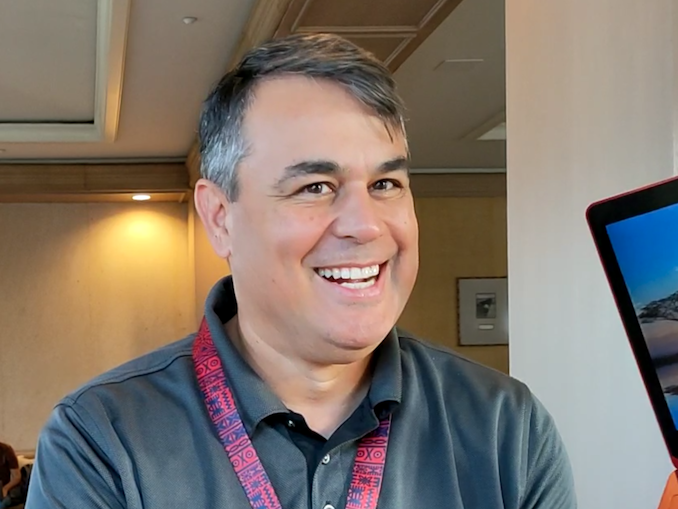 Miguel Nunes Miguel NunesQualcomm |
 Ian Cutress AnandTech |
Ian Cutress: My first question I think is one that's quite personal to me, because I've been waiting for it for so long! We finally got the announcement that 64-bit x86 emulation is coming to everything Snapdragon 7c and above running Windows 11. Why has it taken so long?
Miguel Nunes: It took a bit of time to get right! If there is one thing we've seen going through a lot of these application journeys, is that there's a lot of badly written software out there! I mean, there is. It has nothing to do with the architecture really, but the software can be horribly… just the amount of issues you run into. It is not stuff you expect. Just strange stuff pops up that you need to work through.
IC: Are you talking like instruction flow not really mapping properly to the core?
MN: There was some of that, but you’ll probably understand what I mean when I say that half the stuff we saw was installer bugs doing ‘if machine’ type checks. So the install fails, or the driver doesn't unload because it's trying to put it in the x86 directory. I mean just little things like that, that has caused problems. So yeah, while it should have worked on paper but it doesn't because it's in the wrong place, or the DLL isn’t loading, stuff like that. We took a while to get there. In terms of instruction optimizations, I think there are some that aren't super optimized, but that wasn't the majority of issues. The majority of issues are mostly just loading issues, CPU detections, and there's a lot of software out there that use libraries they get from somewhere else. Those libraries are doing the right thing, so it's just a linking problem, and it took a bunch of time to get that stuff ported. So you'll see a bunch of open-source stuff ported as well. It just takes time to get that ready.
IC: So it's not necessarily an instruction translation issue, it was dealing above that at the OS layer?
MN: Yeah, it was stuff we didn’t expect. But it [Windows] is a legacy ecosystem that hasn't changed - so nobody's had that problem before!
IC: And compared to some other x86 translation models by your competitors, who own their own ecosystem, sign the software, they don't necessarily have those issues.
MN: [nods] That’s right.
IC: There were some previews with Windows 10 with it enabled, but you’re doing a clean cut with Win11. Is there a technical reason behind locking it into Windows 11?
MN: Not our decision. There’s nothing technical.
IC: So it’s purely a next generation of hardware, it's all Windows 11, so let's have that as the starting point?
MN: Yeah, it wasn't a Qualcomm decision. You’re right, because if you think about the previous OS is Windows 10, and Windows 11 is the new platform. It was a Microsoft decision of where it lands.
IC: At this event, I know this year Qualcomm isn’t saying much about the Nuvia acquisition, but at the launch Qualcomm said that in 2022 there would be sampling silicon, for 2023 products. That was reiterated that at the investor day a month ago. So everything's still on course?
MN: Yes.
IC: Just to clarify for me, is Nuvia working on a specific core? Or is it a full SoC, paired with an Adreno GPU and Qualcomm’s 5G and others?
MN: It's a good question, because I know everyone thinks ‘Nuvia chip’. It requires a lot more of a chip than what Nuvia had [when we acquired them]. They were mainly the CPU core at the time. There is a fabric around that as usual that glues it together, with our optimized memory IP and stuff around that. So think of it more on the CPU performance subsystem. On the GPU, we've got the GPU assets in Adreno. We're [going to be] making a lot of changes there too. On the GPU side we’ll be making it more PC friendly, and then we are scaling the other stuff such as AI, and other things like that too. Nuvia is part of the solution, but there's other stuff there of course.
IC: Traditionally Qualcomm has used a big/little, or a big/medium/little hybrid design. It sounds to me that Nuvia is solely working on that high-performance core. Can you expand if they're doing an equivalent efficiency-core to go with it? Should we expect that to be something to be called Kryo?
MN: We will have two core structures that will be similar to be what we already have. We really believe that the performance and the efficiency optimized combinations work. We see that in our long battery life data, because a lot of the workloads don't need that performance. So you will see that structure still in place - what exactly we do on each core, is TBD. But you will see a similar structure - you just won't see a bunch of big cores!
IC: The goal with the Nuvia design is to scale from 7c+, all the way up?
MN: Oh, eventually we want to use it across the board. This technology scales really well. As Cristiano and others have mentioned, our focus primarily is going to be after the higher performance computing first, but our roadmap will scale. The other thing we will see us try to do, which we've been trying for a while in this industry, is to accelerate. The notebook industry is a little bit slower than the mobile industry, so how do we accelerate the pace of innovation? So you'll see some activity there as well so that we can really drive innovation faster.
IC: At the investor day, it was quite poignant that on the slide it said ‘Nuvia Team’. So should we think of the Nuvia team as a separate design house internally, compared to say, Kryo and Adreno? I'm wondering to what level they're integrated into the company? Last I heard, they were still in the same offices they were when they were a startup!
MN: I think a lot of that is just COVID, regarding offices and things like that. But no, they're part of the company, and they're part of the team here. I see them as our CPU team. We do have different teams, so it's hard to say because some teams in one location will work on a core, others work on another core, but at the end of it, they're part of a team. They’re just part Qualcomm, they're not separate, just part of our CPU team.
IC: In terms of internal roadmaps, the big focus with Nuvia is this first laptop-focused chip in 2023. Usually when we speak to companies, especially the size that Qualcomm is, we discuss 3-year, 5-year roadmaps, and then 7-year exploratory roadmaps. Is that all on the cards with the Nuvia team?
MN: Oh absolutely. We're looking how we scale the capabilities way into the future. Do you want to see our long-term roadmap?
IC: Yes, please!
MN: [laughs] But for sure, you know it's something we want to leverage as much as we can. The technology is great, we've got the performance, we've got the efficiency, and we've got so much IP that we feel pretty good. You've probably gathered that, as we hinted at analyst day, we feel pretty good that we can build out. It’s really awesome.
IC: One question that has come up which I think is relevant given what Apple is doing in the space - A lot of the senior staff at Nuvia are the people who actually were behind that chip. But because Qualcomm is focused on this Windows on Snapdragon ecosystem, do you see the competitor for that Nuvia laptop to be Apple because both the chips are ARM-based, or Intel, because with Intel, you're both using Windows as the main operating system?
MN: That is a really good question. You know, I would honestly say both, and both in the sense that, there's going to be ‘within ecosystem’ competition, because one ecosystem is a Windows ecosystem and one is a Mac ecosystem. It also depends on the segment. I would say it's probably a segment question. Because if you look at certain segments, Windows is king, and that is saying they are the majority of that segment. So for there, Intel is our competition. Then for other segments, we can provide the same capabilities, if not better, than what Apple is doing. So it depends on the lens you're looking at it though, but it's really both. And we're fairly agnostic, and honestly, if it's Windows or if it's Chrome in that space, our value is independent of the operating system. There's a lot of work that goes into the operating system tuning and, getting the product working well, which Microsoft spends a bunch of time doing, but you know, our platform is independent of that.
IC: So at this event, you're announcing Snapdragon 8cx Gen 3. Is it a holdover until the Nuvia-equipped chips are ready?
MN: No, no, not at all. The way I would see it, and when you see the stuff we talked about when you get your hands on - the data we showed puts our 8cx Gen 3 as a mainstream product. So you'll see our comparisons are against mainstream Core i5, which is really still the mainstream CPU for consumers. So that's where 8cx Gen 3 competes really really well. You'll see the performance, the power, and you’ll see the AI story perform really well. That's what we meant to do.
It was targeted there, targeted at the main segment. Our roadmap in the future takes us in a different level of performance. So it's just literally different tiers, and we believe we have to keep the tiers going, because this market is a killer market. Even our Snapdragon 7c+, the stuff we're doing there is really keeping the good/better/best model going and bringing value to the entry tiers. It’s really interesting actually - the entry tier has evolved so much over the past 24 months, more than I think anybody expected, and so there's a lot of value there, too. So we will continue to go after the good/ better/best or the low/mid/ high type of products.
IC: So one of the things that has interested me is that Qualcomm plays a lot in this ultra-thin, ultra-portable market – it’s called an ACPC, but it's ultra-portable with additional connectivity in a traditional sense. What's the scope for going beyond that? Currently we see the ultra-portable market around 15-20 watts, maybe up to 28 watts, but then the laptop space also expands to 45 and 65 watts. Qualcomm has Adreno graphics IP that the company keeps saying it scales – but does it scale to something bigger?
MN: It's an interesting question. You know, this wattage thing, either way, it drives me crazy, because what are you comparing it to? TDPs are a little bit mysterious as it depends on how you measure TDP. But we will deliver performance TDP, and this ‘higher level TDP performance’ at a lower tier. So even you'll see today, when we'll show you will show you i5 level performance, which is at a 22 watts TDP, we deliver it at like 9 watts. So we'll deliver perf at a TDP.
Honestly, you know, to tell you the truth - we can scale pretty high. It's what the market wants, and what products we aim to compete with. But we want to compete in the ultra-mobility space because it’s important to us. We are not focused on desktops today and things like that, but if the market sees value, and our products are good in that market, it's something we definitely look at. We focus on the mobile market, but with a much higher level of performance at a lower TDP.
IC: So just for my personal edification, when you say ‘22 watts performance at 9 watts’, that's great. But I just want that same efficiency at 22 Watts!
MN: You want higher performance at the same TDP! Which again, it's a good question - very few people understand that. It's going to be an OEM design point choice. The OEM decide if it wants to build a thinner form factor, or it wants higher perf at the same TDP. I think there's probably a combination of both, but we will scale fairly well, but still at a significantly lower TDP than what you would get with others - significantly. So then the question is whether it is time [for Qualcomm to move into the new market]? I mean, I'm a big fanless believer, and so I like fanless designs. But we could scale on the technology. So it's really about what are the products the right design points/
IC: I'm coming to your event with the Intel flagship EVO design laptop – a Core i7-1195G7 in the MSI Prestige 14. On the plane it gives me 16 hours battery life - which I know is still technically six hours less than what Qualcomm provided three years ago, but it runs all my software. At what point does Qualcomm demand a minimum specification? You already have reference designs - at what point do you design with your partners an equivalent to the Intel EVO ecosystem ensuring that all designs meet very specific certification, as well as driver support over 12/24 months ensuring that performance is still high? Is there scope for that sort of platform in your ecosystem?
MN: You know we don't have a platform like that. It's interesting - we believe that every product should be optimized. That’s where we work with our partners - we really push that aggressively. Every product should be optimized to the best capabilities. You'll see this when we talk about security, as we’re not simply throwing a bunch of security features in there. We don't believe, we don't want an EVO programme, we don't want a different thing - everybody should get a good minimum. Why shouldn't you, as a consumer. get the best security? You don't want to go create a bunch of sub-brands and confusion in the market - we want every product to be highly optimized.
Ultimately, just look for the Snpadragon logo, and you get security, and you get higher efficiency. Maybe it's a scale thing, as we can do it now, because we are working with a smaller number of designs. In reality, we could do it, and but we just want to get to a point where we the software is so highly optimized, we won't see a lot of product variants that are outside of components selection.
IC: I’ve got a few choice words for some of your partners on that!
MN: [laughs] It's not like getting in the x86 world, as when you design those things, cooling is a big deal because it’s going to throttle if you don’t optimize. That's not an issue for us. We have a good system design, and it's easier for people to follow - then it comes down to component choice: are they picking the right displays that are not power-hungry, stuff like that.
IC: So I notice you have a Snapdragon 8cx Gen 3 laptop beside you - is that the Qualcomm reference design, or is that a partner design?
MN: It’s our design.
IC: What’s so special about it?
MN: It's actually what we use to develop o. It's a real thing, it’s a real PC, and it's a real form factor. It's usable, and I use it as my daily device now, so it's a real thing.
IC: So it's a development platform, not a reference design?
MN: For us it’s a development platform, both hardware and software. We have a bunch of connectors in here that connect and stuff, but it's as close to a real product as possible.
IC: It’s a very vibrant red!
MN: Snapdragon red. That's why we had it made.
IC: Do you mind me asking who your partner with that is?
MN: We used one of the more mainstream ODMs. We designed it and they just manufactured it.
IC: And you’ve got two cameras at the top?
MN: Yes, and we have other demos with other cameras in the demo room.
IC: Speaking of things that use AI functionality, I use NVIDIA’s RTX voice on my main PC for live recordings to help with background noise. But if I already have audio recorded, there's no RTX Voice-like post-processing software that I can just drag a file into. If you have the hardware, can Qualcomm do it?
MN: When you asked me this last night (before the event), I said I’d look into it for you. The result is I think we can! We’re preparing a demo on it. I asked the internal team if we can post-process, and we actually can.
IC: Also on the AI front, this has been one of Qualcomm’s strengths in smartphones. But when it comes to laptop design, your competitors have a problem with the fact that there aren't that many applications that they can focus on when they talk about AI, aside from camera, and they start clutching at straws to promote the AI. Ultimately they’re optimizing some software that has limited scope. So how are you approaching the messaging and the application as it comes to ACPC AI?
MN: We'll have some demos on stage today with us with Microsoft, and you will see them talk about AI and some of the things they're doing. We see significant value for AI in productivity use cases. If you just think about all the stuff that's happening in the cloud, Office 365, there's a bunch of stuff. There's a lot of AI processing in cloud today, but you want to bring that closer to the edge. So a lot of productivity things for Office, and a lot of things in Microsoft Teams. A lot of it is centered on the camera, but it's not just for pictures, it's for taking the camera inputs and using it for things. So you'll see a lot of innovation around that.
As you know, the processing power you need to run that stuff is very high. In our Snapdragon 8cx Gen 3, we have 29 TOPs of AI. It's just massive amounts of AI performance, and we will use it all.
IC: Is that 29 TOPs for CPU, GPU plus Hexagon, all three combined together? (MN: Yes) Do you actually have software that can use all three simultaneously, or are you relying on three separate applications using it?
MN: It depends on the software. There is software that could go across them, and then for some software it makes sense to use one accelerator versus the other. But you could go across them if you wanted to.
IC: So could I argue that you're focusing a lot on corporate use case for AI acceleration first, because that's been your major market today?
MN: Correct, yes. I think that's where we all relate to, because we've been using these things so much for Teams, and Zoom, and things like that. There is just so much stuff you can do to make those experiences better. Resolution cleanups, I mean, there are so many things you can do.
IC: Video upscaling? So you can just transmit 240p and it scales to 1080p?
MN: Lots of things like that. Cleaning the background lights, as cameras on these things aren't always great, to make it look better. So there are lots of different things around that, and we've got a big focus on camera too - cameras have become super important in PCs all of a sudden. So a lot of work on camera, audio, and it's a lot of use cases including productivity, so it's not just one thing.
IC: Please mandate a minimum 1080p 60 fps camera in every Snapdragon laptop!
MN: Oh, I wish I could! I would like to go higher than that! But yes, we know what you mean.
IC: With everything Qualcomm is announcing at Tech Summit about ACPC, what do you think will fly under the radar that people should actually focus on?
MN: It's a good question. There are certain things we're doing to camera, and with audio, where people have it good today, but it's not great. It could be so much better. The enhancements we're making are really going to make it so much better. Some of this stuff is not new per se, but it's significantly better than what most have, and it's possible to improve those experiences and I think a lot of the laptop experiences are becoming closer and closer to your phone.
IC: Do those experiences still rely on the OEM buying into those features?
MN: Not that much. In fact, one of the things we want to do, and back to your Evo questions, is just to make sure that some of this stuff is everywhere. Just the basic capabilities that everybody should get - it's not optional and it's just in your product. Everybody should have great audio, and we will work to make sure that those features are there. Even with cameras, as an example, we’re working with the sensor ecosystem to make sure that the PC OEMs have access to sensors that are actually better than 720p. There's a whole enablement piece to go make those things standard. Our goal is to ensure every device is going to have a great experience, not just the special ones that OEMs that choose to make.
Many thanks to Miguel and his team for their time.


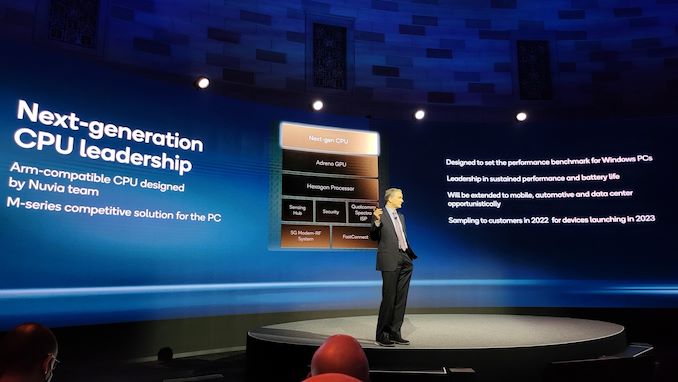
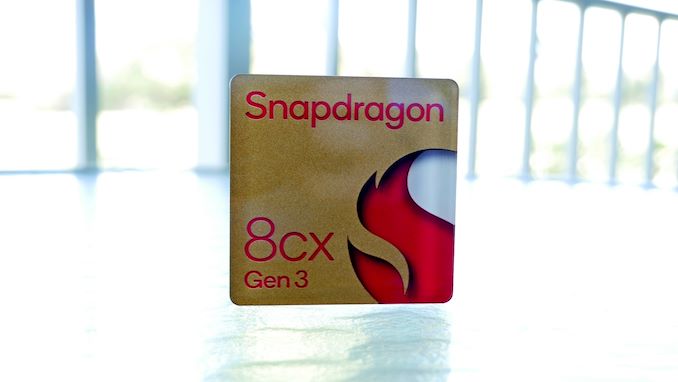
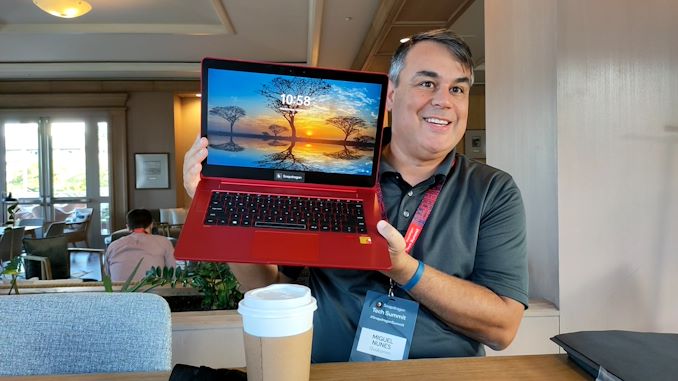
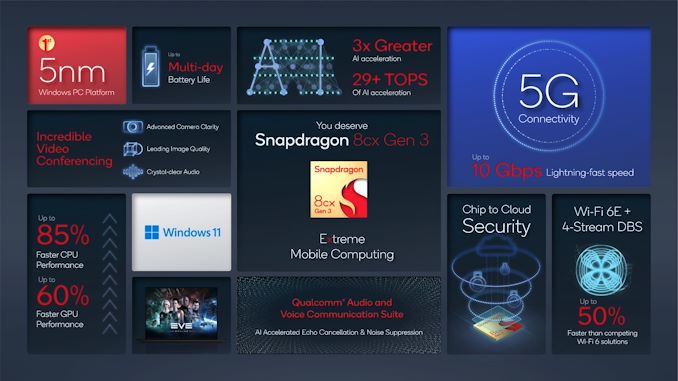








37 Comments
View All Comments
abufrejoval - Wednesday, February 16, 2022 - link
While I’d very much like an ARM based laptop with i5 like computing power at fully passive TDP, I wouldn’t want to run Windows on it, nor x86 code for that matter. Emulations are cool, I run my last good Apple (a ][ )as such, but less relevant than ever, open source compiles to any ISA and the most intensive workloads need accelerators anyway.Where I used to have no more than a single PC from 1981 to around 1995, these days I have dozens in various form factors and most of them are tied to certain use cases, not single purpose mind you, but not everything on each either.
And for the sit-down work after years of home-office, nothing is as important as a big screen any more, 40-50” and at least 4k. I’ve got a wonderful Ryzen 5800U based notebook with a high-res 16:10 screen on 13.3” that I would have died for only a few years ago, but when I take it out for some work away from the desk, I feel almost claustrophobic, just because it’s too small to keep eyes on more than a single thing, even worse when there is a conference going on, too.
Really seamless wireless (optical?) docking, without a single plug and with any screen in the house or office would be a welcome treat much more important than two continuous days on a single charge: I rarely stay for days in places without a socket and even 65Watt chargers are tiny these days.
That Ryzen has just about the same scalar peak power as my monster workstation for as long as I tolerate to wait for any answer, while the multicore performance obviously suffers in this form factor, rarely though to the point where it hurts: that’s why I have beefy workstations and giant servers to do that type of work.
And I can’t see myself gaming on something in this form factor, pretty much the only (on-premise) workload that really stresses the hardware, even if they were able to fit 400 Watts of GPU power into that form factor at single digit TDP, which even ARM won’t do for the foreseeable future. And gaming is currently the only holdback for Windows, everything else I do on a laptop is starting to be done better with the same Linux that runs on the back-ends.
I’d value fanless over extra punch at 15 Watts TDP also because I dislike what dust and crumbs do to a laptop’s insides and might provide the extra space that a replaceable (or really long-life) battery requires.
The only good thing about Windows 11 is that it starts to look like KDE, the fact that it starts to talk home as soon as you hit the start button, is simply inacceptable, an invasion of my personal computing space where Microsoft only had permission to run an operating system not my life.
Which is why Microsoft’s attempt to lock these machines down as Windows 11 hardware is so terribly dangerous and needs to be countered before they launch.
Microsoft wants to overtake Apple on the slow lane and pervert the personal computer into a “super-block-mode” terminal for its cloud orchestrated AI, using NPU IP blocks for local analytics that I see more directed against the user’s best interest than serving only the person which bought the device only to have its loyalty misdirected to Macrosoft. Let that remain Apple’s domain, if anyone's, for those who prefer convenience over sovereignty.
GeoffreyA - Wednesday, February 16, 2022 - link
In the early stages, I was tempted, horribly so, to install Windows 11, but I held out and don't feel the pang any more. The thing that saved me was reflecting, why do I need to make a mess of my taskbar, why do I have to go through more trouble to open Task Manager, and why do I need to lose Quick Launch? After that, I washed my hands of the ISO and said, keep it, Microsoft.mode_13h - Sunday, February 20, 2022 - link
Eventually, you'll have some hardware that's only supported under Windows 11. That's how they get you.GeoffreyA - Thursday, February 24, 2022 - link
This weekend, I finally tried 11 in a VM and was put off from the start. As others have pointed out, it seems very like an incomplete house. From a functional point of view, none of it feels sensible or intuitive. Usually, the new aesthetics are hindering the path of efficient action. Some genius at Redmond led the redesign of the context menu generations were familiar with. I got the feeling that, having grown weary of minimal design, Microsoft tried to "do up" their looks, making it worse. Isolated, some elements looked all right; but coming together in the tapestry of the OS, it's clearly drawing attention away from, and obscuring, function. Ashamed of who it was, 11 put on a posh, mobile, MacOS look, but ended up looking cheap and making Windows an embarrassment once more.Evidently, it's following in the footsteps of its illustrious predecessors, ME, Vista, and 8.
mode_13h - Thursday, February 24, 2022 - link
> having grown weary of minimal design, Microsoft tried to "do up" their looksSome elements of Windows 10 is too minimal for me. I have apps where you cannot easily see which window has focus, because they toned down the cues so much. Even after I customized what's easily customizable, it's still not great.
Another example is the scrollbar-hiding. They really went too far with the minimalistic push, to the point of making the UI less usable.
GeoffreyA - Friday, February 25, 2022 - link
Yes, the scrollbar-hiding is silly. I think the overdone minimalism was a reaction to the ornate style of Vista and 7. I liked XP's plain, almost cartoonish style the best. It was actually minimalistic, and helped you forget about the OS and get the work done. Microsoft should implement a theming system where you get to choose which Windows appearance you want (98, XP, Aero, 10). It would solve much complaint targeted at new Windows versions.mode_13h - Saturday, February 26, 2022 - link
> Microsoft should implement a theming system where you get to choose> which Windows appearance you want
They probably look at MacOS and the way Apple can succeed in spite of its paternalistic attitude and feel that gives them license to do the same. And I'm sure they tell themselves all kinds of things about the importance of a consistent user experience.
GeoffreyA - Sunday, February 27, 2022 - link
Well, I wonder what the users had to say. Anyway, MS seems always stuck in Apple's shadow when it comes to the GUI, as if they're ashamed of Windows. Aero, the centered titles in 8, and now the centred taskbar, which is like a cheap version of the dock.Raqia - Wednesday, February 16, 2022 - link
You may have much better options very soon:https://www.androidauthority.com/windows-11-androi...
mode_13h - Sunday, February 20, 2022 - link
> I wouldn’t want to run Windows on itYeah, it's really too bad Ian didn't ask about Linux support. Qualcomm doesn't have a good track record, there.
> I’ve got a wonderful Ryzen 5800U based notebook with a high-res 16:10 screen on
> 13.3” that I would have died for only a few years ago, but
> when I take it out for some work away from the desk, I feel almost claustrophobic,
> just because it’s too small to keep eyes on more than a single thing
Yup, same. I have no interest in hunching over a small laptop screen. Laptop ergonomics are horrible.
Maybe what you need is a VR HMD for computing on the go? Full, wrap-around screen! Hopefully, the resolution of mainstream units should be getting to a good point, within the next couple of generations. That said, I'd hate to be wearing a HMD all day. Best in limited doses.